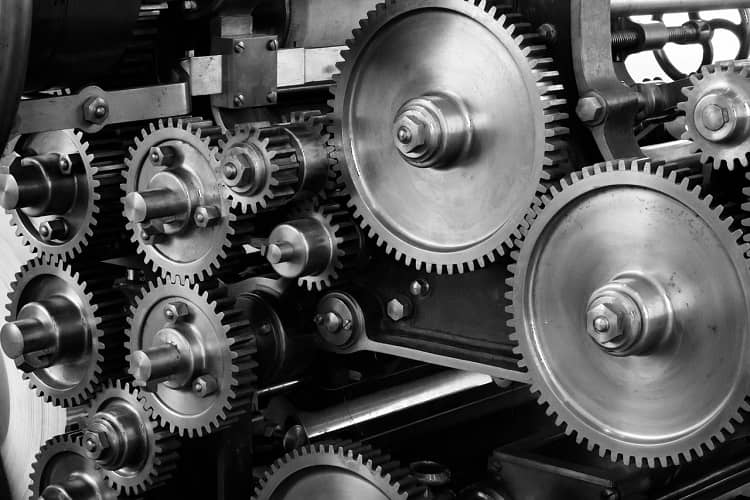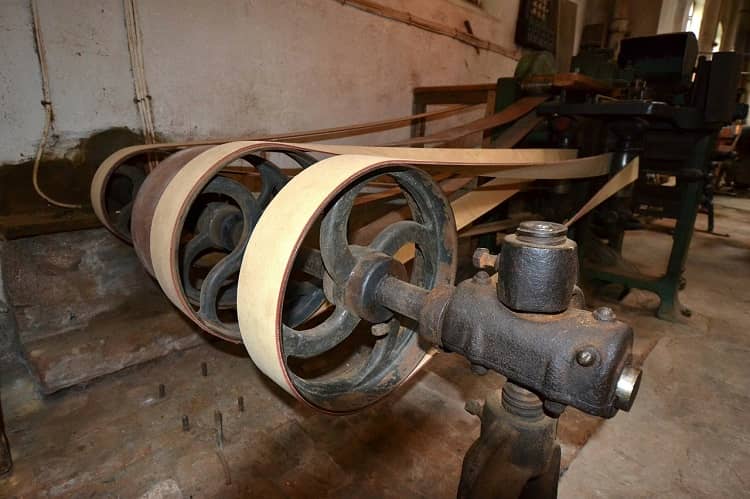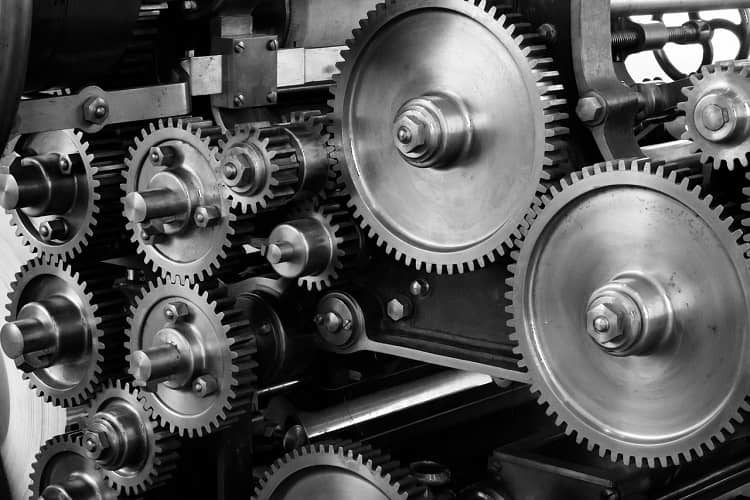Every machine requires a source of energy to perform certain task. Electric motor is predominantly used as power source for industrial machineries. Apart from electric motor, other prime movers such as steam turbine, hydraulic turbine, wind mill, etc. are also used in some specific applications. Mechanical power transmission system retrieves mechanical power from such prime movers and subsequently delivers the same to the machine unit. It can also change the direction of rotation and alter the rotational speed to better match the requirement. The transmission system includes four drives (gear drive, belt drive, chain drive and rope drive) and few elements (pulley, sprocket, shaft, key, coupling, brake, clutch, etc.). Each drive has certain advantages over others and is suitable for specific applications.
These four mechanical drives can be classified in several ways. Based on the means of power transmission, such drives can be classified as friction drive and engagement drive. In friction drives, power is transmitted by means of friction force between two mating parts, as in case of belt drive and rope drive. In engagement drive, power is transmitted by means of successive engagement and disengagement, as in case of chain drive and gear drive. Another criteria of classifying mechanical drives is the presence or absence of flexible element. A flexible drive is one that consists of one intermediate flexible element between the driver and driven shafts, as in case of belt, chain and rope drives. Opposite to this, a rigid drive does not contain any intermediate element. Here two rigid bodies remain in direct contact, for example gear drive.

Another criteria of classifying mechanical drives is whether it can provide constant velocity ratio. A positive drive is free from slip, creep and polygonal effect and thus can provide constant velocity ratio. Only gear drive satisfies this condition; whereas, other three drives are non-positive drives. Therefore, gear drive is one engagement type positive drive that is used to transmit motion, torque and power between driver and driven shafts, preferably over short distance. Since it is rigid drive, it can transmit heavy power without noticeable problem. On the other hand, belt drive is a friction drive that is specifically suitable for medium to larger distance power transmission. Various differences between gear drive and belt drive are given below in table format.
Table: Differences between gear drive and belt drive
| Gear Drive | Belt Drive |
|---|---|
| Gear drive is one type of engagement drive. | Belt drive is one type of friction drive. |
| In gear drive, driver and driven shafts are connected by rigid links. No intermediate flexible element exist between the two shafts. | In belt drive, driver and driven shafts are connected by intermediate flexible element (belt). |
| It is a positive drive; so velocity ratio remains constant. | It is non-positive drive as slip and creep occur frequently. |
| Gear drive cannot protect the system from impact and overloading. | Slip in belt drive helps protecting the system from impact and overloading. |
| It cannot isolate driver shaft from vibrations on driven shaft. | The intermediate flexible element can absorb vibration and thereby protects driver shaft. |
| It can transmit large torque and power. | Belt drive is not preferred for large torque and power transmission. |
| High speed reduction can be achieved easily. | It cannot provide steep velocity reduction. |
| It is suitable for short distance power and motion transmission. | It is suitable for medium to larger distance power and motion transmission. |
| Driver and driven shafts rotate in opposite directions. Additional gear is required to obtain rotation in same direction. | Driver and driven shafts can be rotated either in same or opposite direction employing flat or close belt system. |
| Gear drive cannot tolerate small amount of locational or angular misalignment. | Small amount of locational or angular misalignment does not pose any problem in belt drive. |
| Gear drive requires full lubrication. Its initial cost and maintenance cost are also higher. | Seldom lubrication is required in belt drive. Moreover, its initial cost and maintenance cost are lower. |
| Here line contact occurs between two mating gears, which results low friction and low power loss. So it provides high efficiency. | Here area contact occurs between belt and pulley. So power loss is more due to high friction, which also results in lower efficiency. |
| Performance of gear drive is not affected by small variation in atmosphere temperature. | Length of belt increases with increase in temperature and thus slip occurs undesirably. |
Engagement drive and friction drive: In mechanical drives, motion and power transmission between two shafts can occur either by means of friction or by means of mating. In belt drive and rope drive, friction force between pulley and belt or rope is utilized to drive the driven shaft. So these are classified as friction drive. Here power transmission capacity relies on the frictional characteristics of contact surfaces. On the other hand, in gear drive and chain drive, successive engagement and disengagement help driving the driven shaft. So they are called engagement drive. Here friction force plays no direct role in power transmission.
Presence of intermediate flexible element: In gear drive, two mating gears come in direct contact via their teeth. No intermediate linkage exist in between two gears. So it is also called a rigid drive. On the other hand, a flexible intermediate linkage exist in other three mechanical drives. For example, in belt drive, the belt itself is one flexible linkage that exists in between two pulleys. This flexible element can absorb vibration that generates on driven shaft; and thus can protect the driver shaft. Such intermediate linkage also gives provision for long distance power transmission without unnecessarily increasing system weight.

Positive drive: A positive drive is one that can provide constant velocity ratio during operation. Such drives are free from slip, creep, polygonal effect, leakage, etc. A gear drive is one positive drive. On the other hand, friction drives (belt and rope drive) are affected by slip and creep. Although chain drive is free from slip, it may not provide constant velocity ratio because of polygonal effect. Thus these are non-positive drive. V-belt and ribbed belt tend to eliminate slip; however, they may not necessarily provide constant velocity ratio, especially when workroom temperature varies substantially.
Vibration damping: One benefit of flexible drive is its inherent capability to absorb vibration. The intermediate flexible element can isolate prime mover from any vibration generates in machine unit. In belt drive, the belt can dampen vibration and thus protects the electric motor. However, in gear drive, such flexible linkage does not exist and thus vibration can transmit from machine unit to the prime mover, which can be dangerous in certain cases.
Heavy power transmission: In gear drive, two rigid bodies come in contact to transmit torque from driver gear to driven gear. Transmission capacity depends mainly on gear size, teeth dimension and gear material. In general, gear drive can be used form low load applications (such as toys, watches, etc.) to heavy duty applications (like gear box, marine drive, etc.). In belt drive, transmission capacity depends on frictional characteristics between belt and pulley as well as initial tension given to belt. Since belt automatically undergoes gradual increment in length, so slip occurs frequently. It is not preferred for heavy load transmission, especially in high speed applications.
Steep speed reduction: Tangential velocity (measured in m/s) of any rotating axisymmetric body is proportional to rotational speed (measured in rpm) and diameter of that body. For all mechanical drives, the tangential velocity of two mating parts must be same. Thus by changing diameter of driver and driven elements, rotation speed can be varied. For example, by increasing diameter of driven pulley keeping the driver pulley unchanged, low rotational speed can be obtained. Gear drive can provide very high speed reduction, starting from 1:1 to 1:100 in a single step. Belt drive, being a friction drive, is not suitable for high speed reduction. It is preferred for 1:1 to 1:4 reduction.
Distance between driver and driven shafts: In gear drive, teeth of two mating gears come in direct contact for power transmission. No intermediate linkage exist here. To transmit power over large distance, bulk gears are required to use, which will consume lot of space and increase system weight. Idle gear can also be employed in such scenario but power loss and system weight will increase. Thus gear drive is preferred for small distance power transmission. On the other hand, in belt drive, two pulleys are connected by an intermediate flexible belt. Length of the belt can be varied according to the centre distance between pulleys. Therefore, it can be advantageously employed for small to long distance power transmission. V-belt is preferred for small distance, while flat belt (open or crossed) is suitable for long distance.
Direction of rotation: If the driver gear rotates in clockwise direction, the driven gear will rotate in counter-clockwise direction, or vice versa. In order to get rotation in same direction, intermediate gear is required to use, which will complicate design and increase power loss. In belt drive, driver and driven shafts can be rotated either in same or opposite direction just by employing open or closed belt drive. However, only flat belt provides this opportunity; V-belt is always kept in open configuration.
Error in fixing: Small amount of angular and positional inaccuracy may randomly occur while fixing gear or pulley with the shaft. Although different types of gear can transmit power in various angular positions, two mating gears must be fixed with the corresponding shafts maintaining high precision. Any misalignment will cause vibration, noise and rapid wear of the teeth. A larger error in setting the gears can also affect velocity ratio. On the other hand, belt drive can tolerate small misalignment; however, it cannot transmit power between two non-parallel shafts.
Lubrication: Since two rigid bodies remain in continuous contact, lubrication is highly desired in gear drive. In most of the high speed or heavy load applications, gear drive requires full lubrication, where the gears (fully or partially) are immersed in lubricating oil. This lubricating oil reduces friction, takes away generated heat and also flows away wear debris. Cost of lubricating oil as another considerable factor for gear drive. Belt drive requires occasional lubrication. In fact, higher than desired lubrication will increase slip and thus power wastage will be more.
Efficiency: Although gear drive is one rigid drive, the contact is a line contact (higher pair). Slip or other relevant power loss phenomenon are not associated with it. Moreover, it is always kept under full lubrication. Thus gear drive provides high efficiency, usually above 99%. On the other hand, belt drive is one friction drive and has surface contact between pulley and belt (lower pair). Loss of power due to friction results lower efficiency in belt drive (around 92 – 96%).
Impact of atmospheric temperature: Gear drive is not affected by small variation in atmospheric temperature and other factors like humidity. Lubricating oil, which has high thermal capacity, tends to mitigate effects of such variation. Since the belt remains open to the atmosphere, a small variation in surrounding conditions can hamper the performance. Length of the belt increases with temperature. Thus slip will increase with rise in surrounding temperature. This requires occasional adjustment in belt tension to keep slip under permissible limit.
Scientific comparison among gear drive and belt drive is presented in this article. The author also suggests you to go through the following references for better understanding of the topic.
- Design of Machine Elements by V. B. Bhandari (Fourth edition; McGraw Hill Education).
- Machine Design by R. L. Norton (Fifth edition; Pearson Education).
- A Textbook of Machine Design by R. S. Khurmi and J. K. Gupta (S. Chand; 2014).


